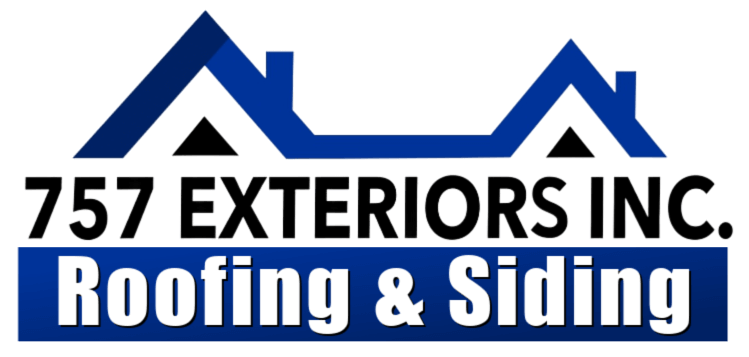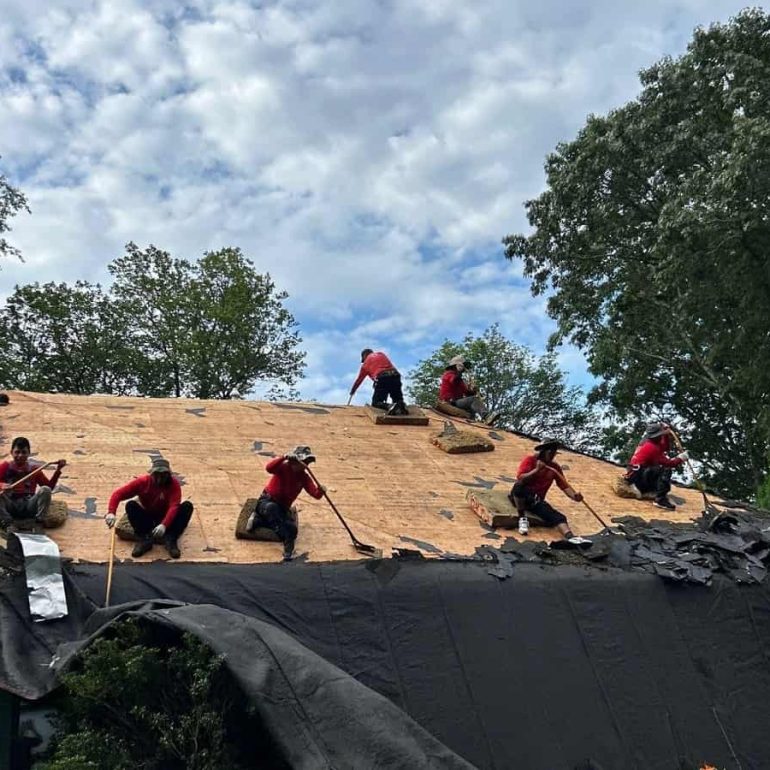Many homeowners focus on the look of their new roof—like the color of shingles or matching trim—but what really protects your home starts beneath the surface. One of the most important yet overlooked components is the underlayment for roofing. This essential layer sits between your roof deck and shingles, acting as a shield against moisture, leaks, and harsh weather. Choosing what is the best roofing underlayment for your home can prevent future damage and improve the long-term durability of your roof.
The underlayment for shingles on a roof works like a backup system. If your shingles are ever damaged or blown off, the underlayment keeps your home safe from rain, ice, and wind. At 757 Exteriors INC, we’ve seen the difference quality underlayment makes—it can be the deciding factor between a small repair and a major leak. That’s why we always recommend investing in durable, high-performance underlayment that’s suited to your climate and roofing materials.
Understanding Roof Underlayment: Your Roof’s Hidden Guardian
Roof underlayment is a water-resistant barrier installed directly onto your roof deck before shingles are applied. This crucial layer serves multiple purposes: it prevents water penetration if shingles are damaged or blown off, provides a clean surface for shingle installation, and offers temporary weather protection during the roofing process.
The underlayment for roofing creates a seamless barrier that directs water away from vulnerable areas like roof penetrations, valleys, and eaves. Without proper underlayment, even the highest-quality asphalt shingles can fail to protect your home adequately.
Modern building codes require underlayment on all sloped roofs, but the type and quality can vary significantly. Understanding your options helps ensure you’re making the best investment for your home’s protection.
Best Type of Underlayment for Asphalt Shingles: Comprehensive Comparison
Synthetic Roof Underlayment: The Modern Choice
Synthetic underlayment has revolutionized roofing protection, offering superior performance compared to traditional materials. Made from polypropylene or polyethylene, synthetic underlayment provides exceptional tear resistance, UV protection, and longevity.
Advantages of Synthetic Underlayment:
- Superior strength and durability
- Excellent slip resistance for safer installation
- Extended UV exposure tolerance (up to 6 months)
- Lightweight yet robust construction
- Consistent thickness and quality
- Better performance in extreme temperatures
Disadvantages:
- Higher initial cost than felt
- Requires careful handling during installation
- Some products may be slippery when wet
Synthetic underlayment pairs exceptionally well with asphalt shingles services and is often the preferred choice for premium roofing systems.
Felt Roof Underlayment: The Traditional Option
Felt underlayment, made from organic or fiberglass materials saturated with asphalt, has been the industry standard for decades. Available in 15-pound and 30-pound weights, felt remains a popular choice for budget-conscious homeowners.
Advantages of Felt Underlayment:
- Lower upfront cost
- Proven track record of performance
- Easy availability
- Familiar to most roofing contractors
- Good performance in moderate climates
Disadvantages:
- Susceptible to tearing and damage
- Limited UV resistance
- Can wrinkle or buckle in extreme temperatures
- Heavier than synthetic alternatives
- Shorter lifespan than synthetic options
Peel-and-Stick Underlayment: Premium Protection
Self-adhering underlayment offers the highest level of water protection, featuring a rubberized asphalt backing that bonds directly to the roof deck. This premium option is often used in critical areas like valleys, eaves, and around roof penetrations.
When to Consider Peel-and-Stick:
- Ice dam-prone regions
- Low-slope applications
- Areas with severe weather exposure
- Premium roofing systems requiring maximum protection
💡 Expert Tip
For optimal performance with asphalt shingles, 757 Exteriors INC recommends synthetic underlayment for most applications. The superior durability and weather resistance justify the modest cost increase, especially when considering long-term roof performance and warranty coverage.
Factors to Consider When Choosing Roof Underlayment
Climate Considerations
Your local climate significantly impacts underlayment selection. In areas prone to ice dams, peel-and-stick underlayment along the eaves provides crucial protection. For high-wind regions, synthetic underlayment’s superior tear resistance offers better security.
Roof Slope and Design
Low-slope roofs require different underlayment strategies than steep-pitched roofs. Complex roof designs with multiple valleys and penetrations benefit from premium underlayment systems that offer superior water management.
Budget and Long-term Value
While felt underlayment costs less initially, synthetic options often provide better long-term value through improved durability and reduced maintenance needs. Consider the total cost of ownership when making your decision.
Shingle Compatibility
Different shingle types may have specific underlayment requirements. Composite shingles services often pair well with synthetic underlayment, while traditional asphalt shingles work with various underlayment types.
Finding Quality Roof Underlayment
Manufacturer Specifications
Always verify that your chosen underlayment meets or exceeds local building codes. Look for products with ASTM certifications and manufacturer warranties that align with your roofing system.
Professional Installation
Even the best underlayment fails without proper installation. 757 Exteriors INC emphasizes the importance of working with experienced professionals who understand proper installation techniques and local building requirements.
Warranty Considerations
Many asphalt shingle manufacturers offer enhanced warranties when paired with specific underlayment products. This compatibility can provide additional peace of mind and potential cost savings.
How to Install Roof Underlayment
Preparation Steps
Proper installation begins with a clean, dry roof deck. All protruding nails should be driven flush, and any gaps or damage should be repaired before underlayment installation.
Installation Sequence
Underlayment should be installed from the bottom up, starting at the eaves and working toward the ridge. Each row should overlap the previous by at least 2 inches on horizontal seams and 6 inches on vertical seams.
Critical Areas
Pay special attention to valleys, roof penetrations, and eaves where water concentration is highest. These areas often require additional underlayment or specialized installation techniques.
Professional Expertise
While DIY installation is possible, professional installation ensures proper technique and warranty compliance. 757 Exteriors INC’s experienced team understands the nuances of underlayment installation for optimal performance.
Installation Process Overview
Step 1: Preparation
Clean deck surface and secure loose boards
Step 2: Starting Point
Begin at eaves with proper overhang
Step 3: Overlap
Maintain proper overlap for water protection
Step 4: Securing
Fasten according to manufacturer specs
Maintenance and Longevity
Regular Inspections
Schedule annual roofing inspections to identify potential issues before they become major problems. Early detection of underlayment damage can prevent costly repairs.
Signs of Underlayment Failure
Watch for interior water stains, ice dam formation, or visible underlayment damage during exterior inspections. These signs may indicate the need for roofing repair or replacement.
Compatibility with Roof Systems
When planning roofing replacement, consider how underlayment choice affects overall system performance. Different roofing materials may benefit from specific underlayment types.
Conclusion: Making the Right Choice for Your Home
Selecting the best roofing underlayment for your asphalt shingle roof requires balancing performance, cost, and long-term value. While synthetic underlayment offers superior performance for most applications, felt underlayment remains viable for budget-conscious projects in moderate climates.
At 757 Exteriors INC, we recommend synthetic underlayment for most residential applications due to its superior durability, weather resistance, and installation safety. However, the best choice depends on your specific needs, budget, and local climate conditions.
Remember that underlayment is just one component of a comprehensive roofing system. Proper installation, quality materials, and regular maintenance all contribute to your roof’s long-term performance and your home’s protection.
Ready to Upgrade Your Roof?
Get expert advice on the best underlayment for your asphalt shingle roof. Our experienced team at 757 Exteriors INC provides professional installation and quality materials for lasting protection.
Call (401) 583-6671Serving Cranston, RI and surrounding areas
Frequently Asked Questions
What is the best underlayment for asphalt shingles?
Synthetic underlayment is generally the best choice for asphalt shingles due to its superior durability, tear resistance, and weather protection. It offers excellent performance across various climate conditions and provides better long-term value than traditional felt options.
How long does roof underlayment last?
Quality synthetic underlayment can last 25-50 years when properly installed, while felt underlayment typically lasts 15-25 years. The lifespan depends on climate conditions, installation quality, and maintenance practices.
Can I install underlayment myself?
While possible, professional installation is recommended to ensure proper technique, warranty compliance, and optimal performance. Improper installation can void manufacturer warranties and compromise your roof’s protection.
Do I need underlayment if I have high-quality shingles?
Yes, building codes require underlayment on all sloped roofs regardless of shingle quality. Underlayment provides crucial backup protection and helps maintain warranty coverage for your roofing system.





